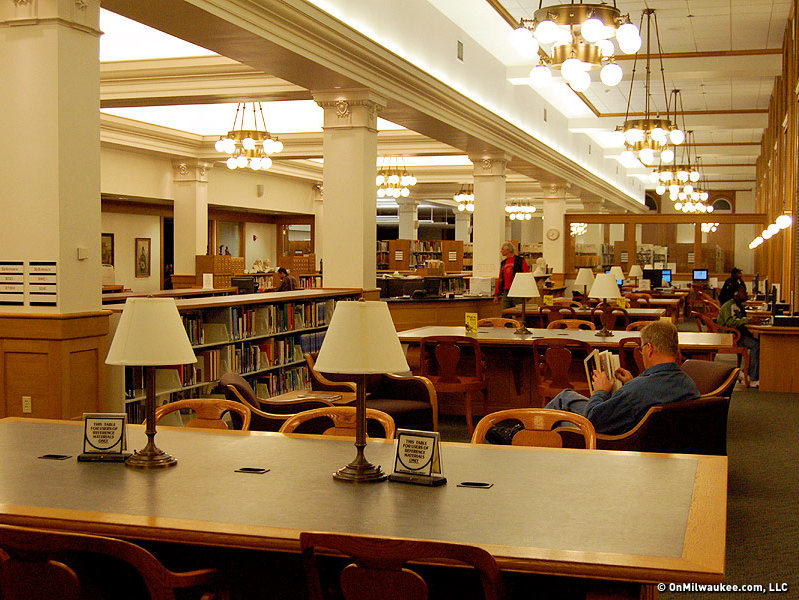Everyone in Milwaukee knows the Art Museum with its sweeping wings and famous collection spanning centuries of artistic periods. Most have been to the Milwaukee Public Museum to stroll "The Streets of Old Milwaukee" or witness a dinosaur attack. Some have even been to Marquette's Haggerty Art Museum or the Milwaukee Historical Society.
But how many people have seen the Richard E. and Lucile Krug Rare Books Room, located in the Milwaukee Public Library's central and main building at 814 W. Wisconsin Ave.?
Sealed behind thick panes of glass in a temperature- and humidity-controlled room where no direct sunlight gets in, this second floor wing holds the Central Art Rarities Collection -- containing some of Milwaukee's most fascinating and precious items that citizens rarely see.
"Some of the books are ones from all of the special collections (including Humanities and others) that rarify over time," says Arts and Humanities Assistant Coordinator Mary Milinkovich, one of only a handful of people allowed to enter the rarities room and retrieve materials for viewing in an adjoining reception area.
"Some are actually ‘artist books,' which are crosses between works of art and rare books. In addition to the printed work on the page, the book itself is a work of art," she explains.
Examples include Japanese art books, the former world-record for smallest printed book and a book of portrait stamps featuring figures' famous last words -- and encased in a small coffin.
One of the most well known non-print items is an original artwork from 1850 by German Romantic painter Carl Spitzberg entitled "The Bookworm." It was the only painting bequeathed by art collector René von Schleinitz that didn't end up at MAM.
It's a picture touched with whimsical humor and highly regarded in the art world; a tall canvas portrays a bespectacled scholar bathed in a shaft of sun while standing atop a ladder facing a lofty bookshelf. Between his legs and under one arm is a book, as well as one in each hand as he intently studies a page. The colorful painting hangs quietly in the darkness of the rarities room, although specific lights are turned on for viewings.
There are many natural history items and items of local historical interest here such as a letter from President Franklin Delano Roosevelt to Milwaukee Mayor Daniel W. Hoan, an oversized Milwaukee autograph book from 1898 and a complete 435 double-elephant folio plate set of John James Audubon's "Birds of America." This beautiful hand-colored and detailed picture book is often considered the best picture book ever produced and a copy sold at Christie's in 2000 for a hefty sum.
The room holds more than 6,000 items, only 30 percent of which Milinkovich says she's has gotten to touch in her four years with the Arts department and 25 years in the MPL system.
"That's what makes the job so exciting is going in there, when people request them it's a kick to have contact with them," Milinkovich says.
The Krug rarities room has been collecting since the library's founding in 1878. It began in earnest with longtime head librarian Richard Krug, but it didn't have an official chamber until the library's major renovations in the late 1990's and it finally opened in 2001.
The room falls under the Arts, Music and Recreation department not just because it houses a 1901 Harley-Davidson manual, a complete run of "The Ring" boxing magazine from 1922-2005 or the early "Settlement" cookbooks. When MPL looked at equally dividing responsibilities among departments along Dewey decimal lines, Library Science and Book Science fell to the department.
The AMR section itself has thousands of sheet music pieces, books on art and rec, and catalog books to look up your own art.
The Central Library itself is technically eight floors -- four above ground and four below. The sub-levels hold still more historical books and reference records for other subject areas.
Many sections in Special Collections including Rare Books are working with a virtual library committee to see what they can afford to digitize and share online. It's a question of manpower and time to sort through the inventory. Some sections, such as the "Remember When ..." articles, have been catalogued and placed online. Others can be looked up and viewed on a computer at the library. But many more items, like Johannes Nider's 1479 book on the Ten Commandments, remain in the vault-like room in physical form only.
In light of the talk of digitization, Milinkovich ruminates that while the Internet is a wonderful and useful thing, that there will always be a place for books.
"(The Internet) gets a sort of glimpse of them which whets people's appetites. But we'll always need the real thing. I don't know when eventually the digital books will get better but there will always be a room for rare books because it's a whole experience and can't feel the history from an electronic representation."







